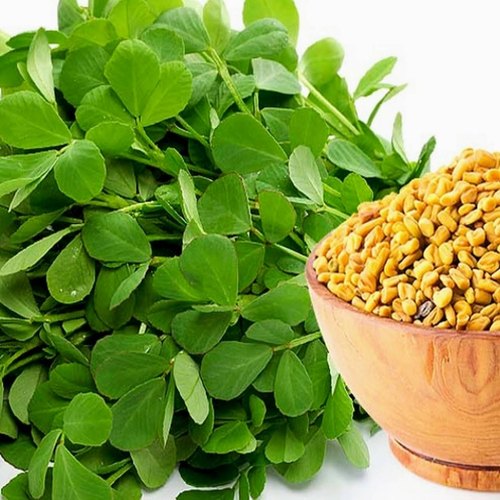Fenugreek also has its unique place among the crops of the puls family. Primarily fenugreek is used in making vegetables, pickles and laddus in winters. It has a bitter taste, but its aroma is delicious. It has many medicinal properties. In addition, it is considered a cash crop. If farmers cultivate it commercially, then good profits can be earned. Let us know how to cultivate it and what precautions should be taken so that good profits can be made even at a low cost. Keeping these things in mind, today we are giving information about fenugreek cultivation to our farmer brothers to get the full benefit of it.
Health benefits of eating fenugreek
Fenugreek is a plant belonging to the Ligumanus family, which is smaller than 1 foot. Its leaves are used as green vegetables, and its grains are used as spices. Therefore, it is very beneficial in terms of health. Fenugreek seeds also contain minerals like sodium, zinc, phosphorus, folic acid, iron, calcium, magnesium, potassium, and vitamins C, B and C.
Apart from this, nutrients like fibre, protein, starch, sugar and phosphoric acid are abundant. It is used in diabetes by making powder and consuming it. Its use is also very beneficial in stomach related diseases. Its consumption provides relief in joint pain. In addition, it’s helpful in high blood pressure (high VP), diabetes and dyspepsia. Green fenugreek helps in reducing blood sugar. Thus, it is consumed as a treatment for many diseases. Be it green fenugreek or fenugreek seeds. Consuming it in both ways helps keep the body healthy.
The leading state in fenugreek production
In India, it is successfully cultivated in all northern India, including Punjab, Rajasthan, Delhi. Gujarat and Rajasthan are the major fenugreek producing states in the country. More than 80% of fenugreek production is done in Rajasthan. Fenugreek is mainly grown during the Rabi season, but it is cultivated during the rainy season in South India. The required machines must be excellent, like Eicher 333 and others.
Things to know before the cultivation of fenugreek
- The cool climate is suitable for the cultivation of fenugreek. Its ability to tolerate frost is higher in comparison to other crops.
- Areas with average rainfall are suitable for its cultivation, and they cannot be cultivated in areas with high rainfall.
- Fenugreek can be cultivated in all soils, but clayey soil with good drainage is more suitable for its cultivation. The pH value of the soil should be between 6-7. And the soil preparations must be with excellent tools and machines
- In plains, it can be sown from September to March, and in hilly areas, it can be planted from July to August.
- If you are cultivating it for vegetables, then sowing should be done at an interval of 8-10 days. So that fresh vegetables are available at all times. And if you want to sow it for its seeds, it can be sown till the end of November.
- Its sowing is mainly done by the sprinkling method.
- It is necessary to have moisture in the field at the time of sowing.
- Along with the fenugreek crop, earning can also be done by growing radish in its med.
- Kharif crops like paddy, maize, green moong and green fodder crops can be grown along with fenugreek.
Improved varieties of fenugreek
There are several types of varieties of fenugreek, which are:
- Fenugreek Seeds
- Lam Selection
- Pusa Early Bunching
- UM 112
- Kashmiri
- Hisar Suvarna
Method of sowing fenugreek
Before sowing of fenugreek:
- Prepare the field well.
- For this, make the soil fine by ploughing the area with the help of indigenous plough or deer.
- At the time of tillage, apply 150 quintals of cow dung per hectare. If there is a problem with termites in the field, then before planting, quinalphos (1.5%) or methyl parathion (2% powder) should be mixed at the rate of 25 kg per hectare.
- Stir well.
It requires 12 kg of seed for sowing in one acre. Before sowing, you should soak the seeds in water for 8 to 12 hours.
To protect the seeds from diseases and pests, treat the seeds with Thiram@4gm and Carbendazim 50%WP@3gm/kg of seed. After chemical treatment, treat seeds with Azospirillium 600 gm + Trichoderma Viraide 20 gm per acre per 12 kg of seeds. Most of the fenugreek seeds are sown by the sprinkling method. At the time of sowing, keep the row to row distance 22.5 cm and sow the seed on the bed at a 3-4 cm depth.
How much yield and how much profit can be made
If the seed is taken after 1 harvest, then the average yield is about 6-8 quintals per hectare, and if 4-5 cuttings are done, then the exact yield is reduced to about 1 quintal per hectare. The yield of bhaji or green leaves is approximately 70-80 quintals per hectare. Let us tell you that fenugreek leaves are also sold after drying, which fetches a price of up to Rs 100 per kg. If fenugreek is cultivated scientifically, then about 50000 rupees can be earned from 1 hectare.
